Melbourne, IA Map & Demographics
Melbourne Map
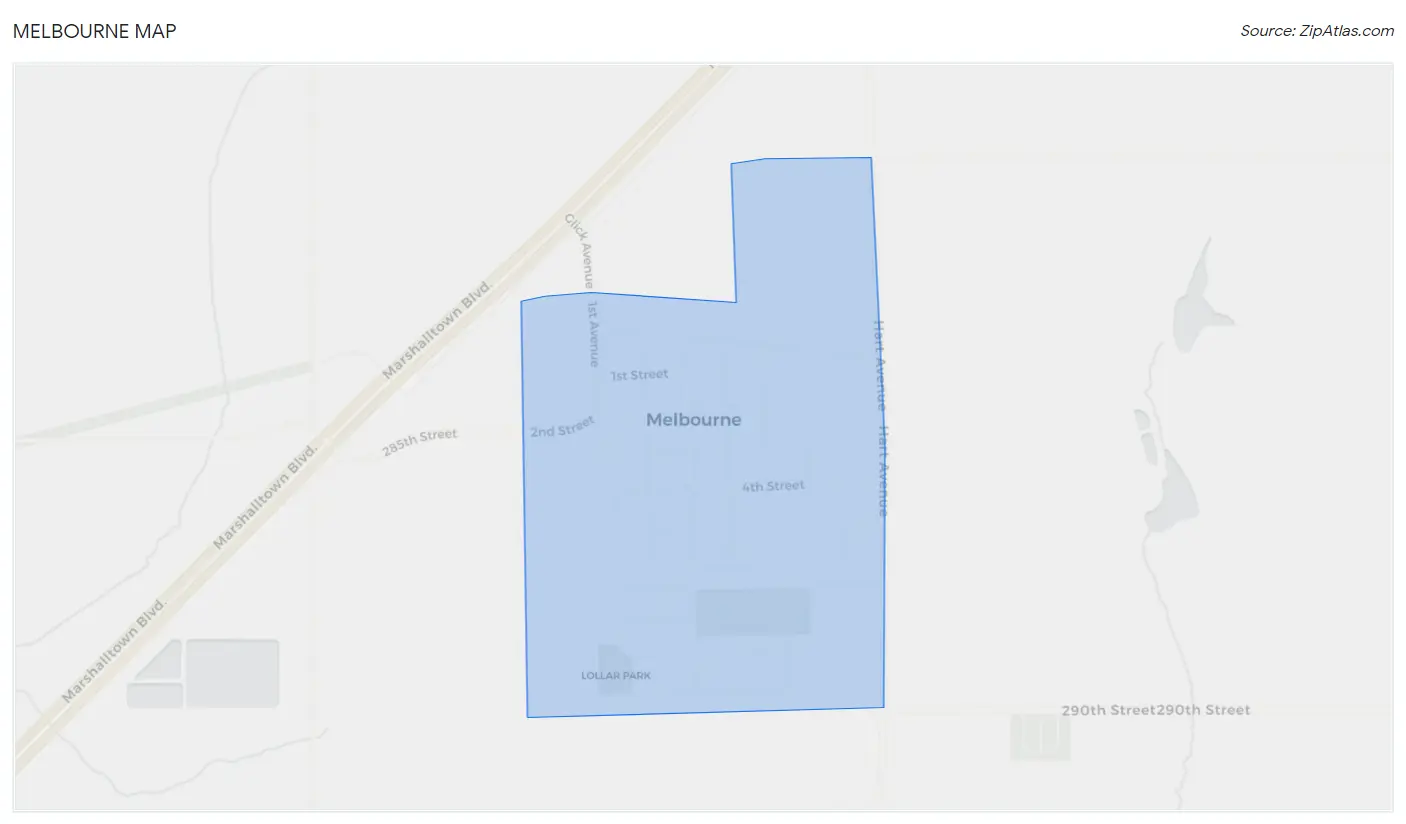
Melbourne Overview
$35,613
PER CAPITA INCOME
$103,125
AVG FAMILY INCOME
$91,500
AVG HOUSEHOLD INCOME
32.7%
WAGE / INCOME GAP [ % ]
67.3¢/ $1
WAGE / INCOME GAP [ $ ]
0.33
INEQUALITY / GINI INDEX
788
TOTAL POPULATION
432
MALE POPULATION
356
FEMALE POPULATION
121.35
MALES / 100 FEMALES
82.41
FEMALES / 100 MALES
35.5
MEDIAN AGE
3.1
AVG FAMILY SIZE
2.7
AVG HOUSEHOLD SIZE
445
LABOR FORCE [ PEOPLE ]
80.8%
PERCENT IN LABOR FORCE
4.3%
UNEMPLOYMENT RATE
Melbourne Zip Codes
Melbourne Area Codes
Income in Melbourne
Income Overview in Melbourne
Per Capita Income in Melbourne is $35,613, while median incomes of families and households are $103,125 and $91,500 respectively.
| Characteristic | Number | Measure |
| Per Capita Income | 788 | $35,613 |
| Median Family Income | 225 | $103,125 |
| Mean Family Income | 225 | $108,748 |
| Median Household Income | 294 | $91,500 |
| Mean Household Income | 294 | $99,330 |
| Income Deficit | 225 | $0 |
| Wage / Income Gap (%) | 788 | 32.69% |
| Wage / Income Gap ($) | 788 | 67.31¢ per $1 |
| Gini / Inequality Index | 788 | 0.33 |
Earnings by Sex in Melbourne
Average Earnings in Melbourne are $45,167, $52,813 for men and $35,547 for women, a difference of 32.7%.

| Sex | Number | Average Earnings |
| Male | 247 (53.7%) | $52,813 |
| Female | 213 (46.3%) | $35,547 |
| Total | 460 (100.0%) | $45,167 |
Earnings by Sex by Income Bracket in Melbourne
The most common earnings brackets in Melbourne are $75,000 to $99,999 for men (40 | 16.2%) and $2,499 or less for women (22 | 10.3%).
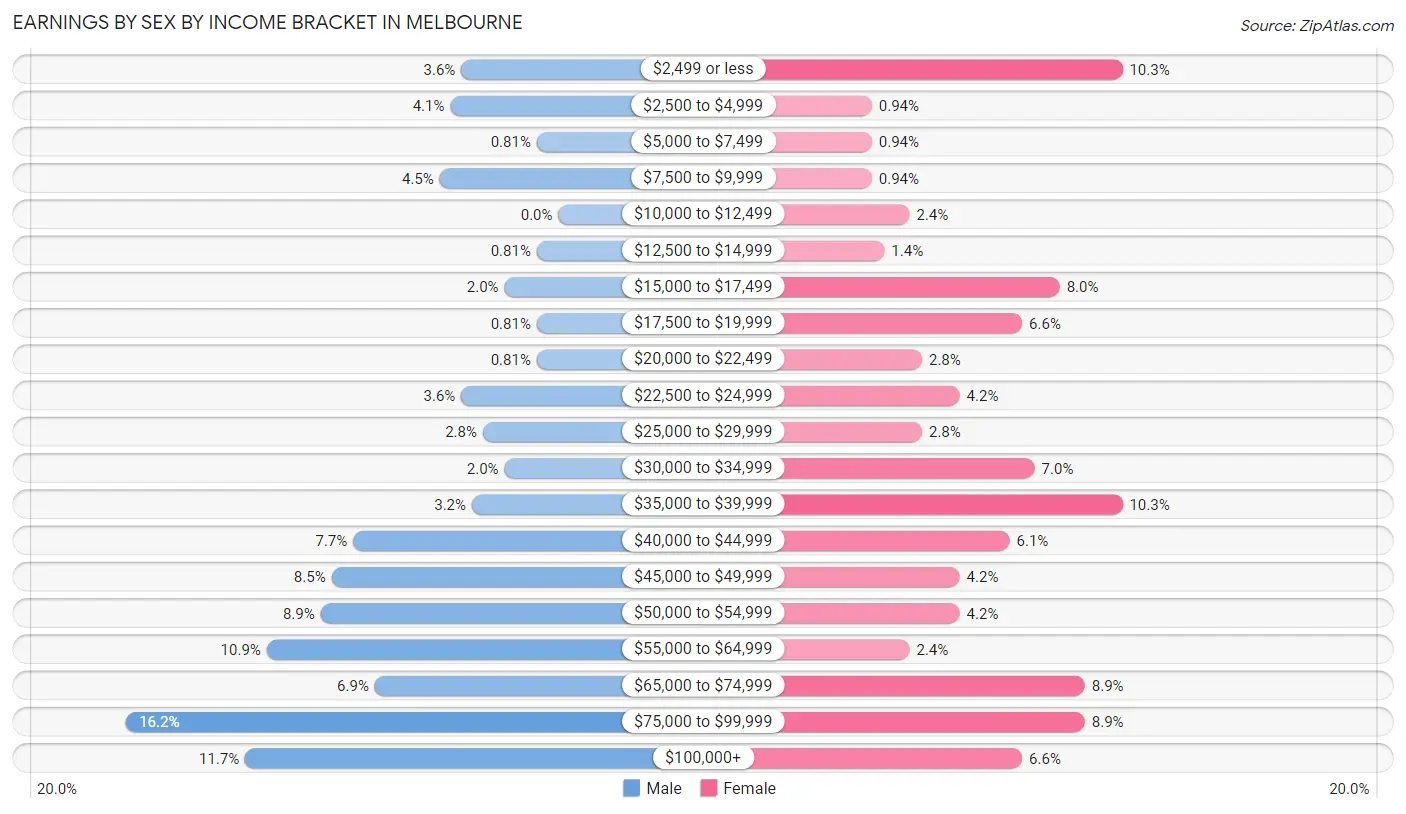
| Income | Male | Female |
| $2,499 or less | 9 (3.6%) | 22 (10.3%) |
| $2,500 to $4,999 | 10 (4.1%) | 2 (0.9%) |
| $5,000 to $7,499 | 2 (0.8%) | 2 (0.9%) |
| $7,500 to $9,999 | 11 (4.4%) | 2 (0.9%) |
| $10,000 to $12,499 | 0 (0.0%) | 5 (2.4%) |
| $12,500 to $14,999 | 2 (0.8%) | 3 (1.4%) |
| $15,000 to $17,499 | 5 (2.0%) | 17 (8.0%) |
| $17,500 to $19,999 | 2 (0.8%) | 14 (6.6%) |
| $20,000 to $22,499 | 2 (0.8%) | 6 (2.8%) |
| $22,500 to $24,999 | 9 (3.6%) | 9 (4.2%) |
| $25,000 to $29,999 | 7 (2.8%) | 6 (2.8%) |
| $30,000 to $34,999 | 5 (2.0%) | 15 (7.0%) |
| $35,000 to $39,999 | 8 (3.2%) | 22 (10.3%) |
| $40,000 to $44,999 | 19 (7.7%) | 13 (6.1%) |
| $45,000 to $49,999 | 21 (8.5%) | 9 (4.2%) |
| $50,000 to $54,999 | 22 (8.9%) | 9 (4.2%) |
| $55,000 to $64,999 | 27 (10.9%) | 5 (2.4%) |
| $65,000 to $74,999 | 17 (6.9%) | 19 (8.9%) |
| $75,000 to $99,999 | 40 (16.2%) | 19 (8.9%) |
| $100,000+ | 29 (11.7%) | 14 (6.6%) |
| Total | 247 (100.0%) | 213 (100.0%) |
Earnings by Sex by Educational Attainment in Melbourne
Average earnings in Melbourne are $57,500 for men and $36,719 for women, a difference of 36.1%. Men with an educational attainment of bachelor's degree enjoy the highest average annual earnings of $63,333, while those with high school diploma education earn the least with $56,875. Women with an educational attainment of bachelor's degree earn the most with the average annual earnings of $40,625, while those with high school diploma education have the smallest earnings of $16,875.

| Educational Attainment | Male Income | Female Income |
| Less than High School | - | - |
| High School Diploma | $56,875 | $16,875 |
| College or Associate's Degree | $57,500 | $35,455 |
| Bachelor's Degree | $63,333 | $40,625 |
| Graduate Degree | - | - |
| Total | $57,500 | $36,719 |
Family Income in Melbourne
Family Income Brackets in Melbourne
According to the Melbourne family income data, there are 62 families falling into the $100,000 to $149,999 income range, which is the most common income bracket and makes up 27.6% of all families.

| Income Bracket | # Families | % Families |
| Less than $10,000 | 2 | 0.9% |
| $10,000 to $14,999 | 0 | 0.0% |
| $15,000 to $24,999 | 9 | 4.0% |
| $25,000 to $34,999 | 6 | 2.7% |
| $35,000 to $49,999 | 14 | 6.2% |
| $50,000 to $74,999 | 34 | 15.1% |
| $75,000 to $99,999 | 45 | 20.0% |
| $100,000 to $149,999 | 62 | 27.6% |
| $150,000 to $199,999 | 40 | 17.8% |
| $200,000+ | 13 | 5.8% |
Family Income by Famaliy Size in Melbourne
5-person families (40 | 17.8%) account for the highest median family income in Melbourne with $114,545 per family, while 3-person families (45 | 20.0%) have the highest median income of $34,792 per family member.

| Income Bracket | # Families | Median Income |
| 2-Person Families | 100 (44.4%) | $68,750 |
| 3-Person Families | 45 (20.0%) | $104,375 |
| 4-Person Families | 28 (12.4%) | $113,929 |
| 5-Person Families | 40 (17.8%) | $114,545 |
| 6-Person Families | 10 (4.4%) | $0 |
| 7+ Person Families | 2 (0.9%) | $0 |
| Total | 225 (100.0%) | $103,125 |
Family Income by Number of Earners in Melbourne
The median family income in Melbourne is $103,125, with families comprising 3+ earners (34) having the highest median family income of $136,250, while families with 1 earner (77) have the lowest median family income of $66,161, accounting for 15.1% and 34.2% of families, respectively.

| Number of Earners | # Families | Median Income |
| No Earners | 14 (6.2%) | $70,000 |
| 1 Earner | 77 (34.2%) | $66,161 |
| 2 Earners | 100 (44.4%) | $113,889 |
| 3+ Earners | 34 (15.1%) | $136,250 |
| Total | 225 (100.0%) | $103,125 |
Household Income in Melbourne
Household Income Brackets in Melbourne
With 65 households falling in the category, the $100,000 to $149,999 income range is the most frequent in Melbourne, accounting for 22.1% of all households. In contrast, only 2 households (0.7%) fall into the $10,000 to $14,999 income bracket, making it the least populous group.

| Income Bracket | # Households | % Households |
| Less than $10,000 | 4 | 1.4% |
| $10,000 to $14,999 | 2 | 0.7% |
| $15,000 to $24,999 | 15 | 5.1% |
| $25,000 to $34,999 | 10 | 3.4% |
| $35,000 to $49,999 | 33 | 11.2% |
| $50,000 to $74,999 | 47 | 16.0% |
| $75,000 to $99,999 | 58 | 19.7% |
| $100,000 to $149,999 | 65 | 22.1% |
| $150,000 to $199,999 | 47 | 16.0% |
| $200,000+ | 13 | 4.4% |
Household Income by Householder Age in Melbourne
The median household income in Melbourne is $91,500, with the highest median household income of $105,833 found in the 25 to 44 years age bracket for the primary householder. A total of 124 households (42.2%) fall into this category. Meanwhile, the 15 to 24 years age bracket for the primary householder has the lowest median household income of $0, with 15 households (5.1%) in this group.

| Income Bracket | # Households | Median Income |
| 15 to 24 Years | 15 (5.1%) | $0 |
| 25 to 44 Years | 124 (42.2%) | $105,833 |
| 45 to 64 Years | 76 (25.9%) | $72,500 |
| 65+ Years | 79 (26.9%) | $75,625 |
| Total | 294 (100.0%) | $91,500 |
Poverty in Melbourne
Income Below Poverty by Sex and Age in Melbourne
With 1.2% poverty level for males and 2.0% for females among the residents of Melbourne, 18 to 24 year old males and under 5 year old females are the most vulnerable to poverty, with 2 males (7.7%) and 2 females (10.0%) in their respective age groups living below the poverty level.
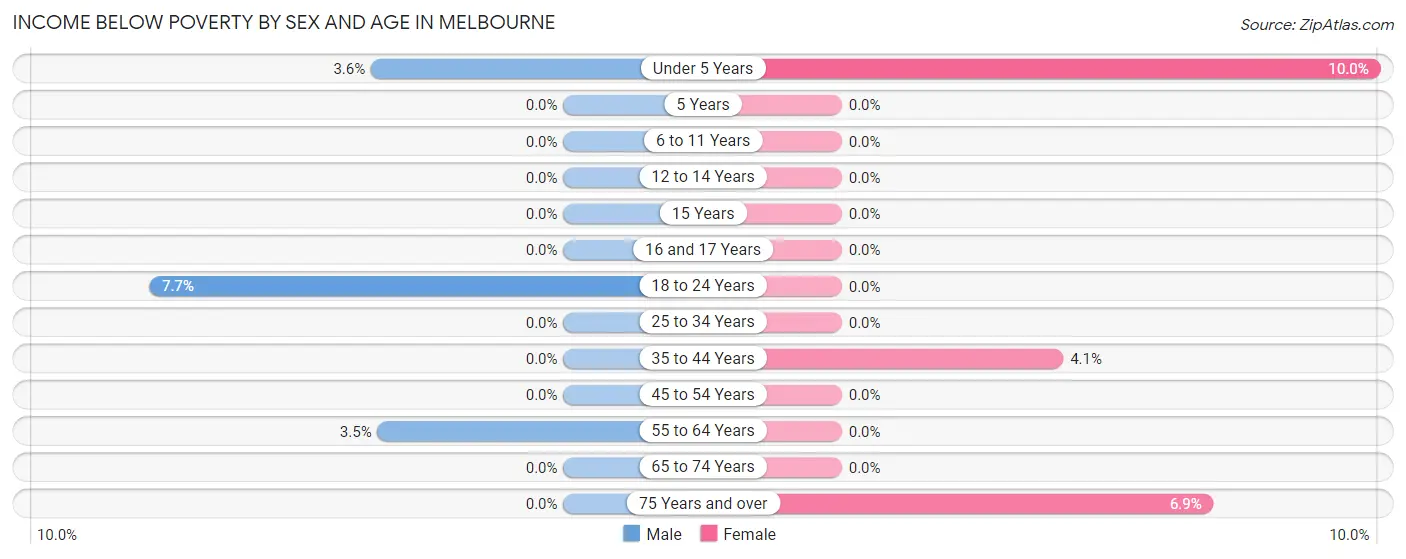
| Age Bracket | Male | Female |
| Under 5 Years | 2 (3.6%) | 2 (10.0%) |
| 5 Years | 0 (0.0%) | 0 (0.0%) |
| 6 to 11 Years | 0 (0.0%) | 0 (0.0%) |
| 12 to 14 Years | 0 (0.0%) | 0 (0.0%) |
| 15 Years | 0 (0.0%) | 0 (0.0%) |
| 16 and 17 Years | 0 (0.0%) | 0 (0.0%) |
| 18 to 24 Years | 2 (7.7%) | 0 (0.0%) |
| 25 to 34 Years | 0 (0.0%) | 0 (0.0%) |
| 35 to 44 Years | 0 (0.0%) | 3 (4.1%) |
| 45 to 54 Years | 0 (0.0%) | 0 (0.0%) |
| 55 to 64 Years | 1 (3.5%) | 0 (0.0%) |
| 65 to 74 Years | 0 (0.0%) | 0 (0.0%) |
| 75 Years and over | 0 (0.0%) | 2 (6.9%) |
| Total | 5 (1.2%) | 7 (2.0%) |
Income Above Poverty by Sex and Age in Melbourne
According to the poverty statistics in Melbourne, males aged 5 years and females aged 5 years are the age groups that are most secure financially, with 100.0% of males and 100.0% of females in these age groups living above the poverty line.
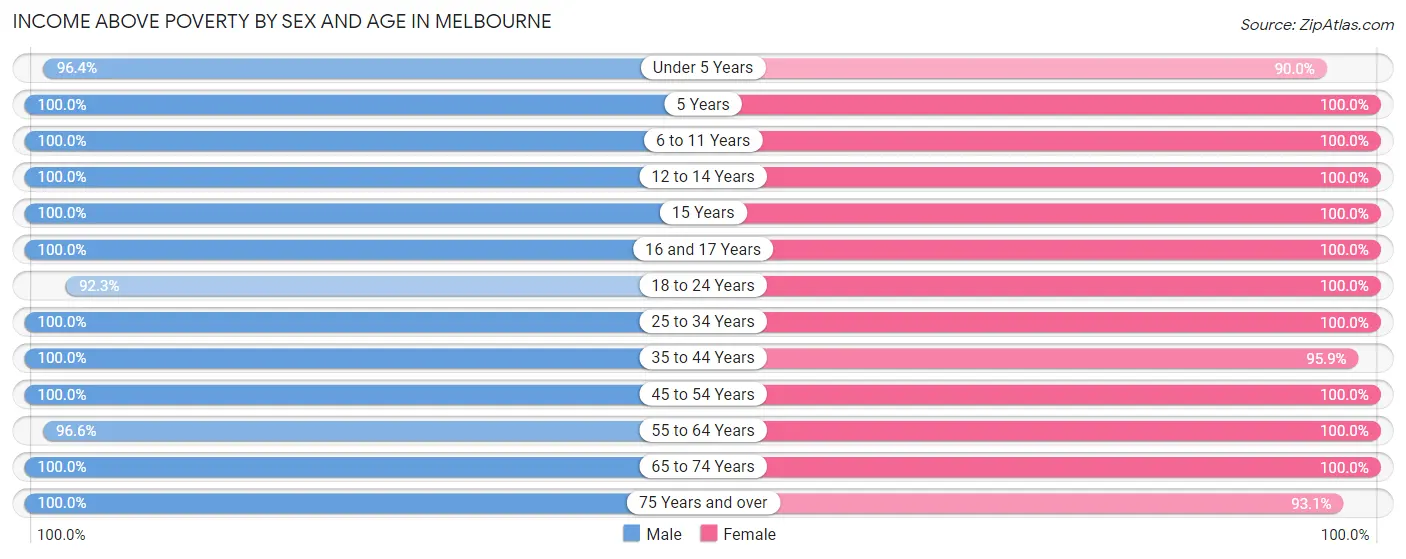
| Age Bracket | Male | Female |
| Under 5 Years | 54 (96.4%) | 18 (90.0%) |
| 5 Years | 7 (100.0%) | 2 (100.0%) |
| 6 to 11 Years | 45 (100.0%) | 43 (100.0%) |
| 12 to 14 Years | 24 (100.0%) | 14 (100.0%) |
| 15 Years | 20 (100.0%) | 6 (100.0%) |
| 16 and 17 Years | 16 (100.0%) | 10 (100.0%) |
| 18 to 24 Years | 24 (92.3%) | 18 (100.0%) |
| 25 to 34 Years | 38 (100.0%) | 43 (100.0%) |
| 35 to 44 Years | 78 (100.0%) | 70 (95.9%) |
| 45 to 54 Years | 47 (100.0%) | 29 (100.0%) |
| 55 to 64 Years | 28 (96.6%) | 27 (100.0%) |
| 65 to 74 Years | 31 (100.0%) | 42 (100.0%) |
| 75 Years and over | 15 (100.0%) | 27 (93.1%) |
| Total | 427 (98.8%) | 349 (98.0%) |
Income Below Poverty Among Married-Couple Families in Melbourne

| Children | Above Poverty | Below Poverty |
| No Children | 76 (100.0%) | 0 (0.0%) |
| 1 or 2 Children | 40 (100.0%) | 0 (0.0%) |
| 3 or 4 Children | 47 (100.0%) | 0 (0.0%) |
| 5 or more Children | 0 (0.0%) | 0 (0.0%) |
| Total | 163 (100.0%) | 0 (0.0%) |
Income Below Poverty Among Single-Parent Households in Melbourne

| Children | Single Father | Single Mother |
| No Children | 0 (0.0%) | 0 (0.0%) |
| 1 or 2 Children | 2 (10.5%) | 0 (0.0%) |
| 3 or 4 Children | 0 (0.0%) | 0 (0.0%) |
| 5 or more Children | 0 (0.0%) | 0 (0.0%) |
| Total | 2 (7.7%) | 0 (0.0%) |
Income Below Poverty Among Married-Couple vs Single-Parent Households in Melbourne

| Children | Married-Couple Families | Single-Parent Households |
| No Children | 0 (0.0%) | 0 (0.0%) |
| 1 or 2 Children | 0 (0.0%) | 2 (5.1%) |
| 3 or 4 Children | 0 (0.0%) | 0 (0.0%) |
| 5 or more Children | 0 (0.0%) | 0 (0.0%) |
| Total | 0 (0.0%) | 2 (3.2%) |
Race in Melbourne
The most populous races in Melbourne are White / Caucasian (781 | 99.1%), Hispanic or Latino (6 | 0.8%), and Two or more Races (6 | 0.8%).

| Race | # Population | % Population |
| Asian | 0 | 0.0% |
| Black / African American | 0 | 0.0% |
| Hawaiian / Pacific | 0 | 0.0% |
| Hispanic or Latino | 6 | 0.8% |
| Native / Alaskan | 1 | 0.1% |
| White / Caucasian | 781 | 99.1% |
| Two or more Races | 6 | 0.8% |
| Some other Race | 0 | 0.0% |
| Total | 788 | 100.0% |
Ancestry in Melbourne
The most populous ancestries reported in Melbourne are German (311 | 39.5%), Irish (103 | 13.1%), American (56 | 7.1%), Norwegian (45 | 5.7%), and English (41 | 5.2%), together accounting for 70.6% of all Melbourne residents.
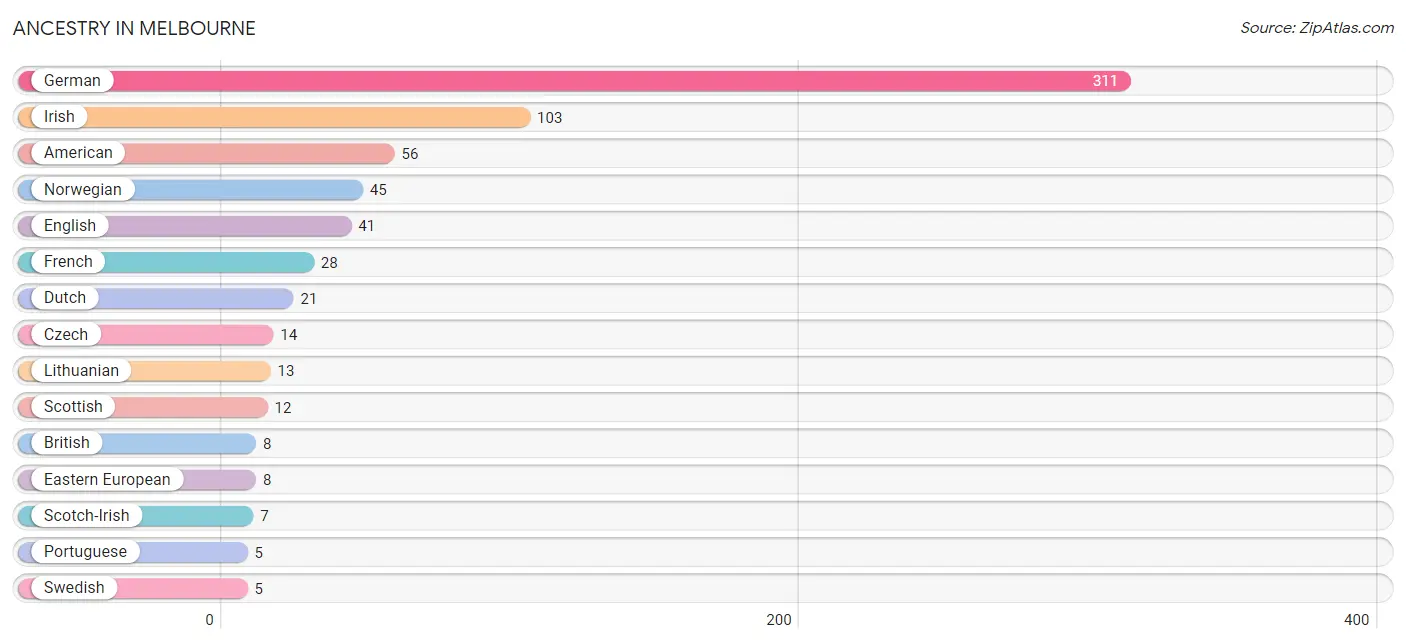
| Ancestry | # Population | % Population |
| American | 56 | 7.1% |
| Arab | 1 | 0.1% |
| Australian | 3 | 0.4% |
| British | 8 | 1.0% |
| Cherokee | 3 | 0.4% |
| Czech | 14 | 1.8% |
| Danish | 4 | 0.5% |
| Dutch | 21 | 2.7% |
| Eastern European | 8 | 1.0% |
| English | 41 | 5.2% |
| European | 2 | 0.3% |
| Finnish | 2 | 0.3% |
| French | 28 | 3.5% |
| German | 311 | 39.5% |
| Hungarian | 2 | 0.3% |
| Irish | 103 | 13.1% |
| Italian | 2 | 0.3% |
| Lebanese | 1 | 0.1% |
| Lithuanian | 13 | 1.7% |
| Mexican | 4 | 0.5% |
| Norwegian | 45 | 5.7% |
| Portuguese | 5 | 0.6% |
| Scotch-Irish | 7 | 0.9% |
| Scottish | 12 | 1.5% |
| Spanish | 2 | 0.3% |
| Swedish | 5 | 0.6% | View All 26 Rows |
Immigrants in Melbourne
The most numerous immigrant groups reported in Melbourne came from Central America (4 | 0.5%), Latin America (4 | 0.5%), Mexico (4 | 0.5%), Europe (3 | 0.4%), and Germany (3 | 0.4%), together accounting for 2.3% of all Melbourne residents.

| Immigration Origin | # Population | % Population |
| Central America | 4 | 0.5% |
| Europe | 3 | 0.4% |
| Germany | 3 | 0.4% |
| Latin America | 4 | 0.5% |
| Mexico | 4 | 0.5% |
| Western Europe | 3 | 0.4% | View All 6 Rows |
Sex and Age in Melbourne
Sex and Age in Melbourne
The most populous age groups in Melbourne are Under 5 Years (56 | 13.0%) for men and 40 to 44 Years (40 | 11.2%) for women.
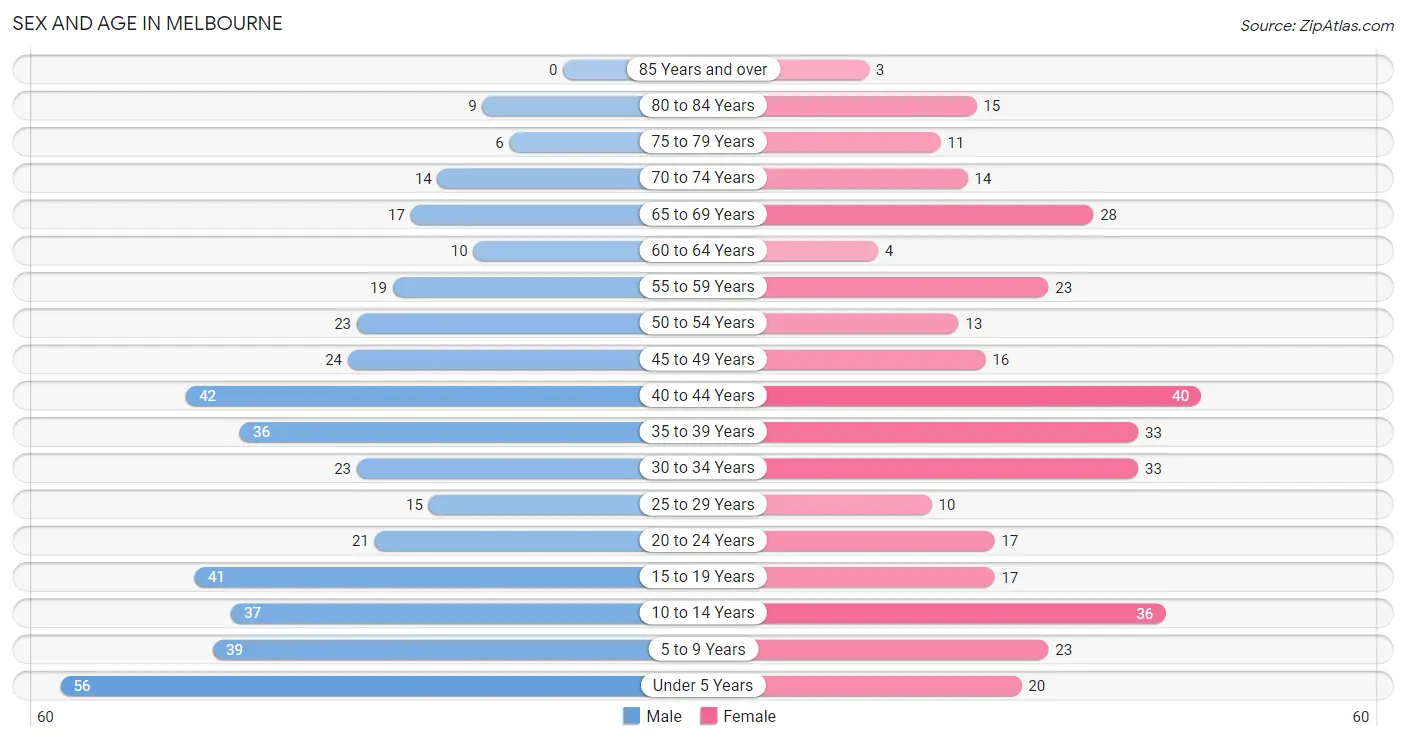
| Age Bracket | Male | Female |
| Under 5 Years | 56 (13.0%) | 20 (5.6%) |
| 5 to 9 Years | 39 (9.0%) | 23 (6.5%) |
| 10 to 14 Years | 37 (8.6%) | 36 (10.1%) |
| 15 to 19 Years | 41 (9.5%) | 17 (4.8%) |
| 20 to 24 Years | 21 (4.9%) | 17 (4.8%) |
| 25 to 29 Years | 15 (3.5%) | 10 (2.8%) |
| 30 to 34 Years | 23 (5.3%) | 33 (9.3%) |
| 35 to 39 Years | 36 (8.3%) | 33 (9.3%) |
| 40 to 44 Years | 42 (9.7%) | 40 (11.2%) |
| 45 to 49 Years | 24 (5.6%) | 16 (4.5%) |
| 50 to 54 Years | 23 (5.3%) | 13 (3.6%) |
| 55 to 59 Years | 19 (4.4%) | 23 (6.5%) |
| 60 to 64 Years | 10 (2.3%) | 4 (1.1%) |
| 65 to 69 Years | 17 (3.9%) | 28 (7.9%) |
| 70 to 74 Years | 14 (3.2%) | 14 (3.9%) |
| 75 to 79 Years | 6 (1.4%) | 11 (3.1%) |
| 80 to 84 Years | 9 (2.1%) | 15 (4.2%) |
| 85 Years and over | 0 (0.0%) | 3 (0.8%) |
| Total | 432 (100.0%) | 356 (100.0%) |
Families and Households in Melbourne
Median Family Size in Melbourne
The median family size in Melbourne is 3.08 persons per family, with married-couple families (163 | 72.4%) accounting for the largest median family size of 3.38 persons per family. On the other hand, single male/father families (26 | 11.6%) represent the smallest median family size with 2.19 persons per family.

| Family Type | # Families | Family Size |
| Married-Couple | 163 (72.4%) | 3.38 |
| Single Male/Father | 26 (11.6%) | 2.19 |
| Single Female/Mother | 36 (16.0%) | 2.36 |
| Total Families | 225 (100.0%) | 3.08 |
Median Household Size in Melbourne
The median household size in Melbourne is 2.68 persons per household, with married-couple households (163 | 55.4%) accounting for the largest median household size of 3.38 persons per household. non-family households (69 | 23.5%) represent the smallest median household size with 1.23 persons per household.

| Household Type | # Households | Household Size |
| Married-Couple | 163 (55.4%) | 3.38 |
| Single Male/Father | 26 (8.8%) | 2.50 |
| Single Female/Mother | 36 (12.2%) | 2.42 |
| Non-family | 69 (23.5%) | 1.23 |
| Total Households | 294 (100.0%) | 2.68 |
Household Size by Marriage Status in Melbourne
Out of a total of 294 households in Melbourne, 225 (76.5%) are family households, while 69 (23.5%) are nonfamily households. The most numerous type of family households are 2-person households, comprising 93, and the most common type of nonfamily households are 1-person households, comprising 54.

| Household Size | Family Households | Nonfamily Households |
| 1-Person Households | - | 54 (18.4%) |
| 2-Person Households | 93 (31.6%) | 15 (5.1%) |
| 3-Person Households | 48 (16.3%) | 0 (0.0%) |
| 4-Person Households | 32 (10.9%) | 0 (0.0%) |
| 5-Person Households | 40 (13.6%) | 0 (0.0%) |
| 6-Person Households | 7 (2.4%) | 0 (0.0%) |
| 7+ Person Households | 5 (1.7%) | 0 (0.0%) |
| Total | 225 (76.5%) | 69 (23.5%) |
Female Fertility in Melbourne
Fertility by Age in Melbourne
Average fertility rate in Melbourne is 48.0 births per 1,000 women. Women in the age bracket of 20 to 34 years have the highest fertility rate with 133.0 births per 1,000 women. Women in the age bracket of 20 to 34 years acount for 100.0% of all women with births.

| Age Bracket | Women with Births | Births / 1,000 Women |
| 15 to 19 years | 0 (0.0%) | 0.0 |
| 20 to 34 years | 8 (100.0%) | 133.0 |
| 35 to 50 years | 0 (0.0%) | 0.0 |
| Total | 8 (100.0%) | 48.0 |
Fertility by Age by Marriage Status in Melbourne
87.5% of women with births (8) in Melbourne are married. The highest percentage of unmarried women with births falls into 20 to 34 years age bracket with 12.5% of them unmarried at the time of birth, while the lowest percentage of unmarried women with births belong to 20 to 34 years age bracket with 12.5% of them unmarried.

| Age Bracket | Married | Unmarried |
| 15 to 19 years | 0 (0.0%) | 0 (0.0%) |
| 20 to 34 years | 7 (87.5%) | 1 (12.5%) |
| 35 to 50 years | 0 (0.0%) | 0 (0.0%) |
| Total | 7 (87.5%) | 1 (12.5%) |
Fertility by Education in Melbourne
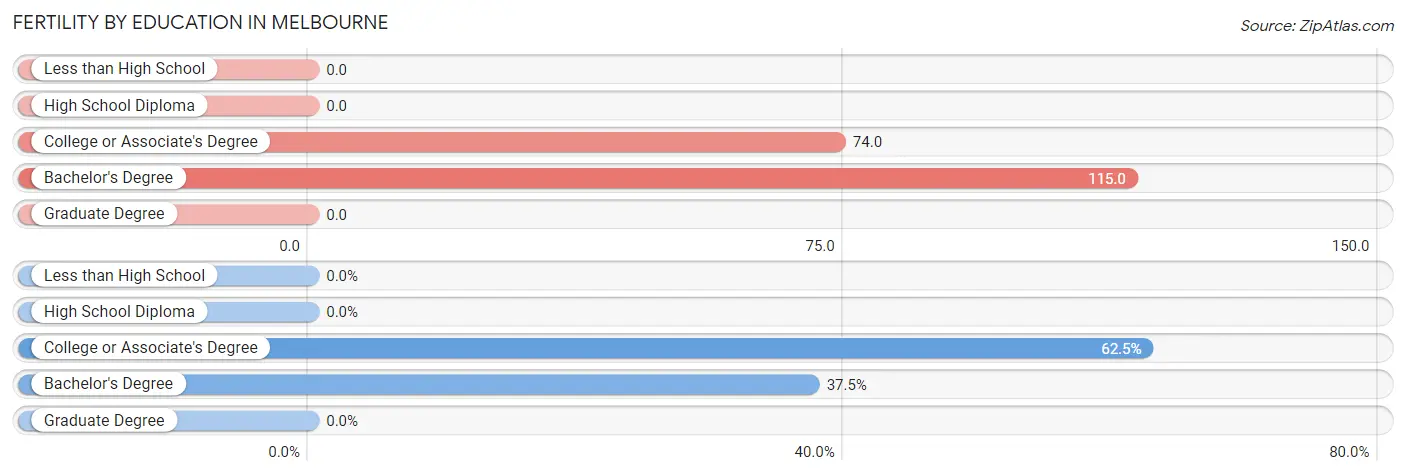
| Educational Attainment | Women with Births | Births / 1,000 Women |
| Less than High School | 0 (0.0%) | 0.0 |
| High School Diploma | 0 (0.0%) | 0.0 |
| College or Associate's Degree | 5 (62.5%) | 74.0 |
| Bachelor's Degree | 3 (37.5%) | 115.0 |
| Graduate Degree | 0 (0.0%) | 0.0 |
| Total | 8 (100.0%) | 48.0 |
Fertility by Education by Marriage Status in Melbourne
12.5% of women with births in Melbourne are unmarried. Women with the educational attainment of college or associate's degree are most likely to be married with 100.0% of them married at childbirth, while women with the educational attainment of bachelor's degree are least likely to be married with 33.3% of them unmarried at childbirth.

| Educational Attainment | Married | Unmarried |
| Less than High School | 0 (0.0%) | 0 (0.0%) |
| High School Diploma | 0 (0.0%) | 0 (0.0%) |
| College or Associate's Degree | 5 (100.0%) | 0 (0.0%) |
| Bachelor's Degree | 2 (66.7%) | 1 (33.3%) |
| Graduate Degree | 0 (0.0%) | 0 (0.0%) |
| Total | 7 (87.5%) | 1 (12.5%) |
Employment Characteristics in Melbourne
Employment by Class of Employer in Melbourne
Among the 421 employed individuals in Melbourne, private company employees (245 | 58.2%), local government employees (46 | 10.9%), and self-employed (incorporated) (40 | 9.5%) make up the most common classes of employment.

| Employer Class | # Employees | % Employees |
| Private Company Employees | 245 | 58.2% |
| Self-Employed (Incorporated) | 40 | 9.5% |
| Self-Employed (Not Incorporated) | 24 | 5.7% |
| Not-for-profit Organizations | 17 | 4.0% |
| Local Government Employees | 46 | 10.9% |
| State Government Employees | 33 | 7.8% |
| Federal Government Employees | 16 | 3.8% |
| Unpaid Family Workers | 0 | 0.0% |
| Total | 421 | 100.0% |
Employment Status by Age in Melbourne
According to the labor force statistics for Melbourne, out of the total population over 16 years of age (551), 80.8% or 445 individuals are in the labor force, with 4.3% or 19 of them unemployed. The age group with the highest labor force participation rate is 25 to 29 years, with 100.0% or 25 individuals in the labor force. Within the labor force, the 75 years and over age range has the highest percentage of unemployed individuals, with 70.0% or 7 of them being unemployed.

| Age Bracket | In Labor Force | Unemployed |
| 16 to 19 Years | 21 (65.6%) | 3 (14.3%) |
| 20 to 24 Years | 36 (94.7%) | 2 (5.6%) |
| 25 to 29 Years | 25 (100.0%) | 2 (8.0%) |
| 30 to 34 Years | 52 (92.9%) | 0 (0.0%) |
| 35 to 44 Years | 142 (94.0%) | 3 (2.1%) |
| 45 to 54 Years | 72 (94.7%) | 0 (0.0%) |
| 55 to 59 Years | 38 (90.5%) | 2 (5.3%) |
| 60 to 64 Years | 9 (64.3%) | 0 (0.0%) |
| 65 to 74 Years | 40 (54.8%) | 0 (0.0%) |
| 75 Years and over | 10 (22.7%) | 7 (70.0%) |
| Total | 445 (80.8%) | 19 (4.3%) |
Employment Status by Educational Attainment in Melbourne
According to labor force statistics for Melbourne, 92.9% of individuals (338) out of the total population between 25 and 64 years of age (364) are in the labor force, with 2.1% or 7 of them being unemployed. The group with the highest labor force participation rate are those with the educational attainment of bachelor's degree or higher, with 97.7% or 86 individuals in the labor force. Within the labor force, individuals with less than high school education have the highest percentage of unemployment, with 50.0% or 2 of them being unemployed.

| Educational Attainment | In Labor Force | Unemployed |
| Less than High School | 4 (44.4%) | 4 (50.0%) |
| High School Diploma | 91 (89.2%) | 3 (3.3%) |
| College / Associate Degree | 157 (95.2%) | 2 (1.3%) |
| Bachelor's Degree or higher | 86 (97.7%) | 0 (0.0%) |
| Total | 338 (92.9%) | 8 (2.1%) |
Employment Occupations by Sex in Melbourne
Management, Business, Science and Arts Occupations
The most common Management, Business, Science and Arts occupations in Melbourne are Health Diagnosing & Treating (33 | 7.7%), Management (32 | 7.5%), Community & Social Service (31 | 7.3%), Health Technologists (25 | 5.9%), and Education Instruction & Library (24 | 5.6%).
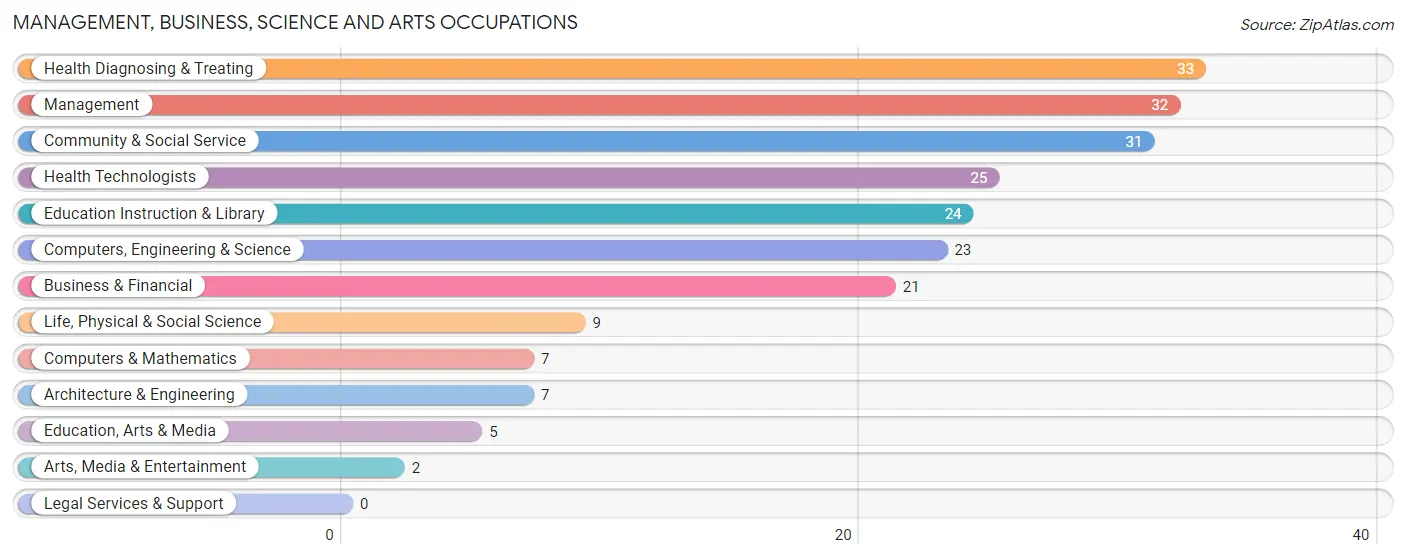
Management, Business, Science and Arts Occupations by Sex
Within the Management, Business, Science and Arts occupations in Melbourne, the most male-oriented occupations are Architecture & Engineering (100.0%), Arts, Media & Entertainment (100.0%), and Computers, Engineering & Science (78.3%), while the most female-oriented occupations are Health Diagnosing & Treating (100.0%), Health Technologists (100.0%), and Education, Arts & Media (80.0%).
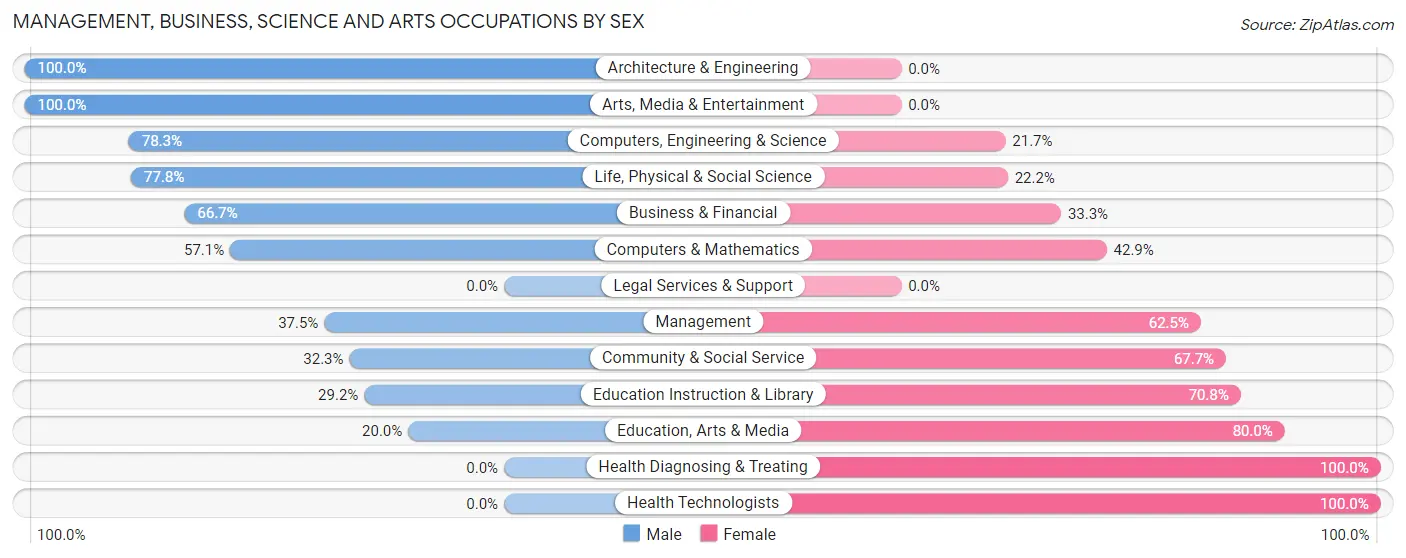
| Occupation | Male | Female |
| Management | 12 (37.5%) | 20 (62.5%) |
| Business & Financial | 14 (66.7%) | 7 (33.3%) |
| Computers, Engineering & Science | 18 (78.3%) | 5 (21.7%) |
| Computers & Mathematics | 4 (57.1%) | 3 (42.9%) |
| Architecture & Engineering | 7 (100.0%) | 0 (0.0%) |
| Life, Physical & Social Science | 7 (77.8%) | 2 (22.2%) |
| Community & Social Service | 10 (32.3%) | 21 (67.7%) |
| Education, Arts & Media | 1 (20.0%) | 4 (80.0%) |
| Legal Services & Support | 0 (0.0%) | 0 (0.0%) |
| Education Instruction & Library | 7 (29.2%) | 17 (70.8%) |
| Arts, Media & Entertainment | 2 (100.0%) | 0 (0.0%) |
| Health Diagnosing & Treating | 0 (0.0%) | 33 (100.0%) |
| Health Technologists | 0 (0.0%) | 25 (100.0%) |
| Total (Category) | 54 (38.6%) | 86 (61.4%) |
| Total (Overall) | 222 (52.1%) | 204 (47.9%) |
Services Occupations
The most common Services occupations in Melbourne are Cleaning & Maintenance (28 | 6.6%), Healthcare Support (26 | 6.1%), Food Preparation & Serving (22 | 5.2%), Personal Care & Service (13 | 3.0%), and Security & Protection (4 | 0.9%).

Services Occupations by Sex
Within the Services occupations in Melbourne, the most male-oriented occupations are Security & Protection (100.0%), Firefighting & Prevention (100.0%), and Law Enforcement (100.0%), while the most female-oriented occupations are Healthcare Support (100.0%), Food Preparation & Serving (90.9%), and Personal Care & Service (46.2%).

| Occupation | Male | Female |
| Healthcare Support | 0 (0.0%) | 26 (100.0%) |
| Security & Protection | 4 (100.0%) | 0 (0.0%) |
| Firefighting & Prevention | 2 (100.0%) | 0 (0.0%) |
| Law Enforcement | 2 (100.0%) | 0 (0.0%) |
| Food Preparation & Serving | 2 (9.1%) | 20 (90.9%) |
| Cleaning & Maintenance | 16 (57.1%) | 12 (42.9%) |
| Personal Care & Service | 7 (53.8%) | 6 (46.2%) |
| Total (Category) | 29 (31.2%) | 64 (68.8%) |
| Total (Overall) | 222 (52.1%) | 204 (47.9%) |
Sales and Office Occupations
The most common Sales and Office occupations in Melbourne are Office & Administration (48 | 11.3%), and Sales & Related (16 | 3.8%).

Sales and Office Occupations by Sex

| Occupation | Male | Female |
| Sales & Related | 5 (31.2%) | 11 (68.8%) |
| Office & Administration | 9 (18.8%) | 39 (81.2%) |
| Total (Category) | 14 (21.9%) | 50 (78.1%) |
| Total (Overall) | 222 (52.1%) | 204 (47.9%) |
Natural Resources, Construction and Maintenance Occupations
The most common Natural Resources, Construction and Maintenance occupations in Melbourne are Installation, Maintenance & Repair (27 | 6.3%), Construction & Extraction (23 | 5.4%), and Farming, Fishing & Forestry (7 | 1.6%).

Natural Resources, Construction and Maintenance Occupations by Sex

| Occupation | Male | Female |
| Farming, Fishing & Forestry | 5 (71.4%) | 2 (28.6%) |
| Construction & Extraction | 23 (100.0%) | 0 (0.0%) |
| Installation, Maintenance & Repair | 27 (100.0%) | 0 (0.0%) |
| Total (Category) | 55 (96.5%) | 2 (3.5%) |
| Total (Overall) | 222 (52.1%) | 204 (47.9%) |
Production, Transportation and Moving Occupations
The most common Production, Transportation and Moving occupations in Melbourne are Transportation (37 | 8.7%), Production (22 | 5.2%), and Material Moving (13 | 3.0%).

Production, Transportation and Moving Occupations by Sex

| Occupation | Male | Female |
| Production | 22 (100.0%) | 0 (0.0%) |
| Transportation | 37 (100.0%) | 0 (0.0%) |
| Material Moving | 11 (84.6%) | 2 (15.4%) |
| Total (Category) | 70 (97.2%) | 2 (2.8%) |
| Total (Overall) | 222 (52.1%) | 204 (47.9%) |
Employment Industries by Sex in Melbourne
Employment Industries in Melbourne
The major employment industries in Melbourne include Health Care & Social Assistance (91 | 21.4%), Educational Services (63 | 14.8%), Manufacturing (47 | 11.0%), Transportation & Warehousing (47 | 11.0%), and Construction (33 | 7.7%).
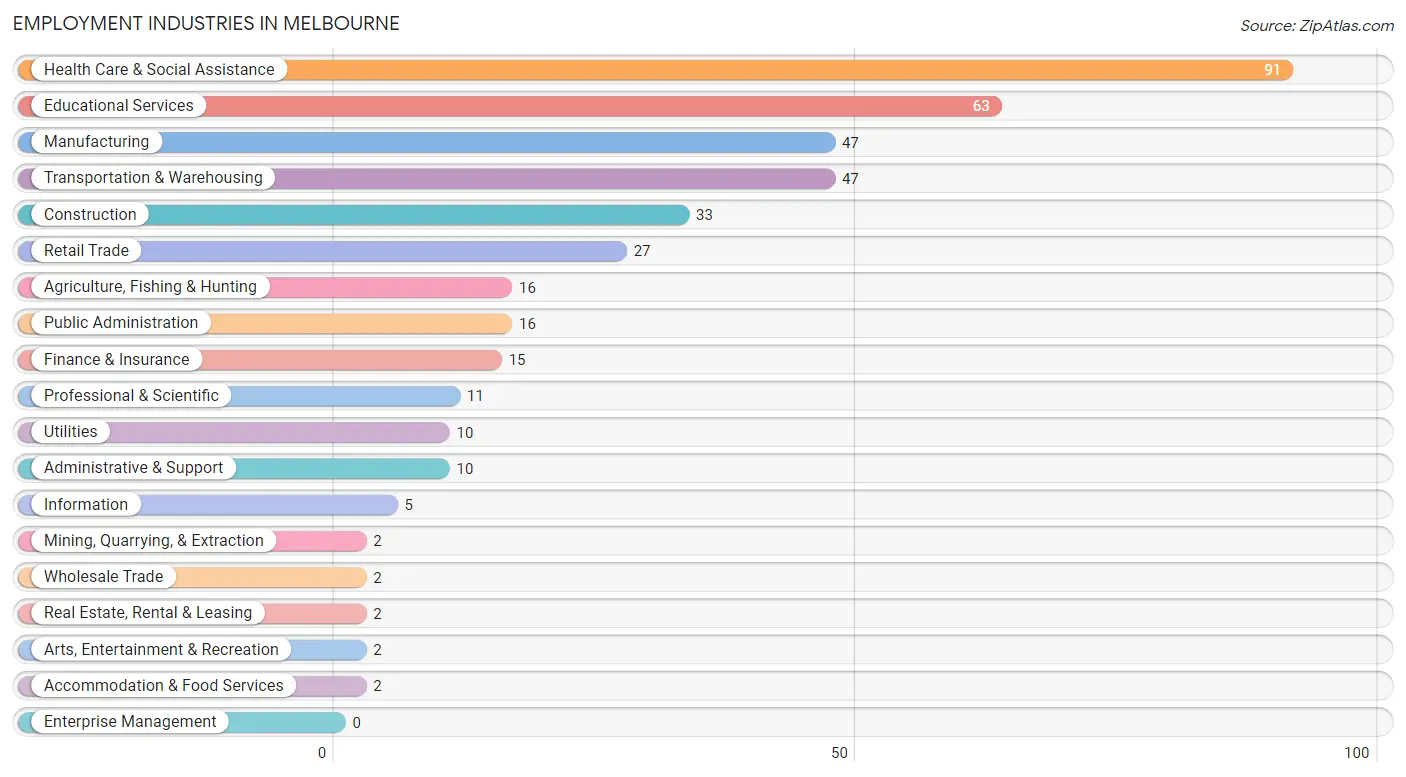
Employment Industries by Sex in Melbourne
The Melbourne industries that see more men than women are Mining, Quarrying, & Extraction (100.0%), Construction (100.0%), and Information (100.0%), whereas the industries that tend to have a higher number of women are Wholesale Trade (100.0%), Real Estate, Rental & Leasing (100.0%), and Accommodation & Food Services (100.0%).
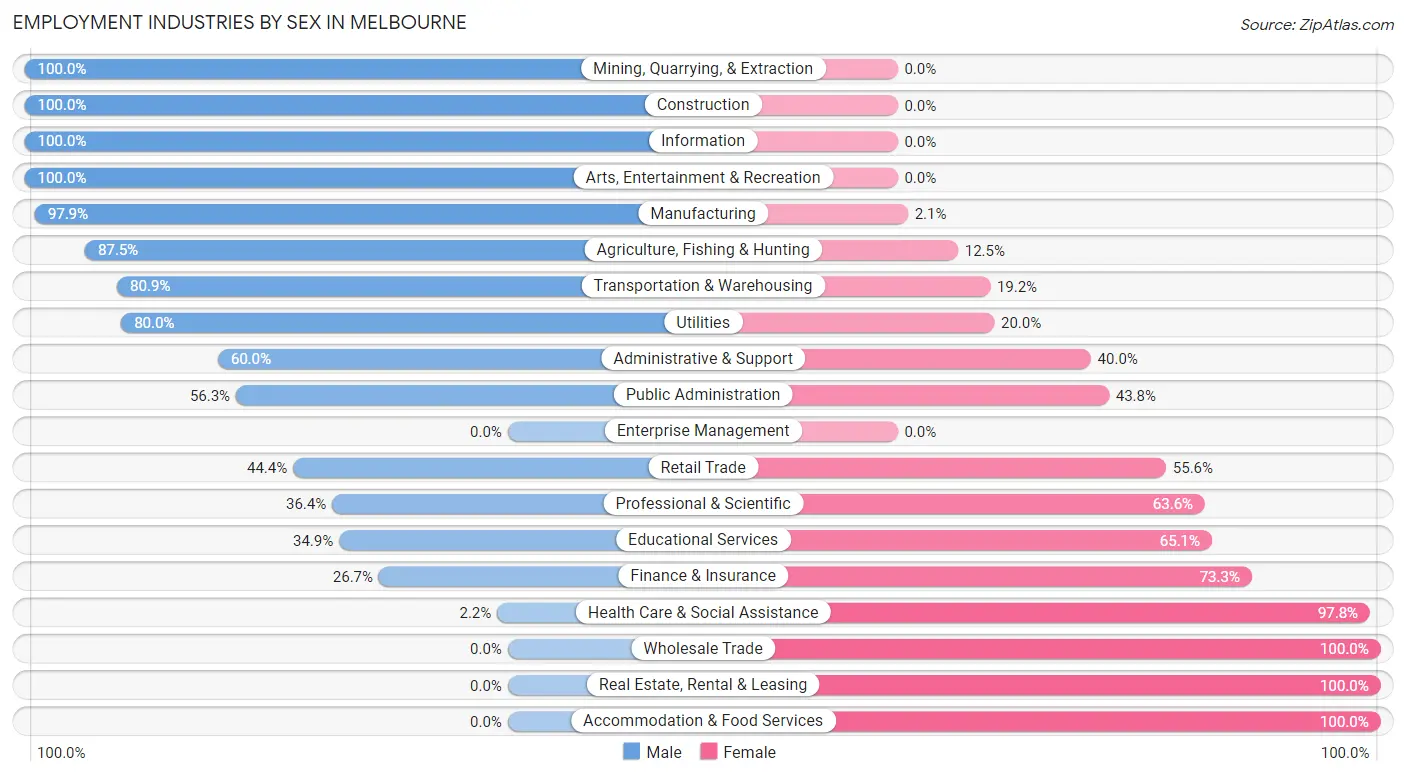
| Industry | Male | Female |
| Agriculture, Fishing & Hunting | 14 (87.5%) | 2 (12.5%) |
| Mining, Quarrying, & Extraction | 2 (100.0%) | 0 (0.0%) |
| Construction | 33 (100.0%) | 0 (0.0%) |
| Manufacturing | 46 (97.9%) | 1 (2.1%) |
| Wholesale Trade | 0 (0.0%) | 2 (100.0%) |
| Retail Trade | 12 (44.4%) | 15 (55.6%) |
| Transportation & Warehousing | 38 (80.8%) | 9 (19.2%) |
| Utilities | 8 (80.0%) | 2 (20.0%) |
| Information | 5 (100.0%) | 0 (0.0%) |
| Finance & Insurance | 4 (26.7%) | 11 (73.3%) |
| Real Estate, Rental & Leasing | 0 (0.0%) | 2 (100.0%) |
| Professional & Scientific | 4 (36.4%) | 7 (63.6%) |
| Enterprise Management | 0 (0.0%) | 0 (0.0%) |
| Administrative & Support | 6 (60.0%) | 4 (40.0%) |
| Educational Services | 22 (34.9%) | 41 (65.1%) |
| Health Care & Social Assistance | 2 (2.2%) | 89 (97.8%) |
| Arts, Entertainment & Recreation | 2 (100.0%) | 0 (0.0%) |
| Accommodation & Food Services | 0 (0.0%) | 2 (100.0%) |
| Public Administration | 9 (56.2%) | 7 (43.8%) |
| Total | 222 (52.1%) | 204 (47.9%) |
Education in Melbourne
School Enrollment in Melbourne
The most common levels of schooling among the 223 students in Melbourne are elementary school (71 | 31.8%), middle school (55 | 24.7%), and high school (51 | 22.9%).

| School Level | # Students | % Students |
| Nursery / Preschool | 16 | 7.2% |
| Kindergarten | 7 | 3.1% |
| Elementary School | 71 | 31.8% |
| Middle School | 55 | 24.7% |
| High School | 51 | 22.9% |
| College / Undergraduate | 20 | 9.0% |
| Graduate / Professional | 3 | 1.3% |
| Total | 223 | 100.0% |
School Enrollment by Age by Funding Source in Melbourne
Out of a total of 223 students who are enrolled in schools in Melbourne, 24 (10.8%) attend a private institution, while the remaining 199 (89.2%) are enrolled in public schools. The age group of 35 years and over has the highest likelihood of being enrolled in private schools, with 2 (100.0% in the age bracket) enrolled. Conversely, the age group of 3 to 4 year olds has the lowest likelihood of being enrolled in a private school, with 14 (100.0% in the age bracket) attending a public institution.

| Age Bracket | Public School | Private School |
| 3 to 4 Year Olds | 14 (100.0%) | 0 (0.0%) |
| 5 to 9 Year Old | 54 (87.1%) | 8 (12.9%) |
| 10 to 14 Year Olds | 67 (91.8%) | 6 (8.2%) |
| 15 to 17 Year Olds | 49 (100.0%) | 0 (0.0%) |
| 18 to 19 Year Olds | 6 (100.0%) | 0 (0.0%) |
| 20 to 24 Year Olds | 6 (46.2%) | 7 (53.8%) |
| 25 to 34 Year Olds | 3 (75.0%) | 1 (25.0%) |
| 35 Years and over | 0 (0.0%) | 2 (100.0%) |
| Total | 199 (89.2%) | 24 (10.8%) |
Educational Attainment by Field of Study in Melbourne
Education (40 | 35.1%), science & technology (18 | 15.8%), business (18 | 15.8%), bio, nature & agricultural (12 | 10.5%), and arts & humanities (10 | 8.8%) are the most common fields of study among 114 individuals in Melbourne who have obtained a bachelor's degree or higher.
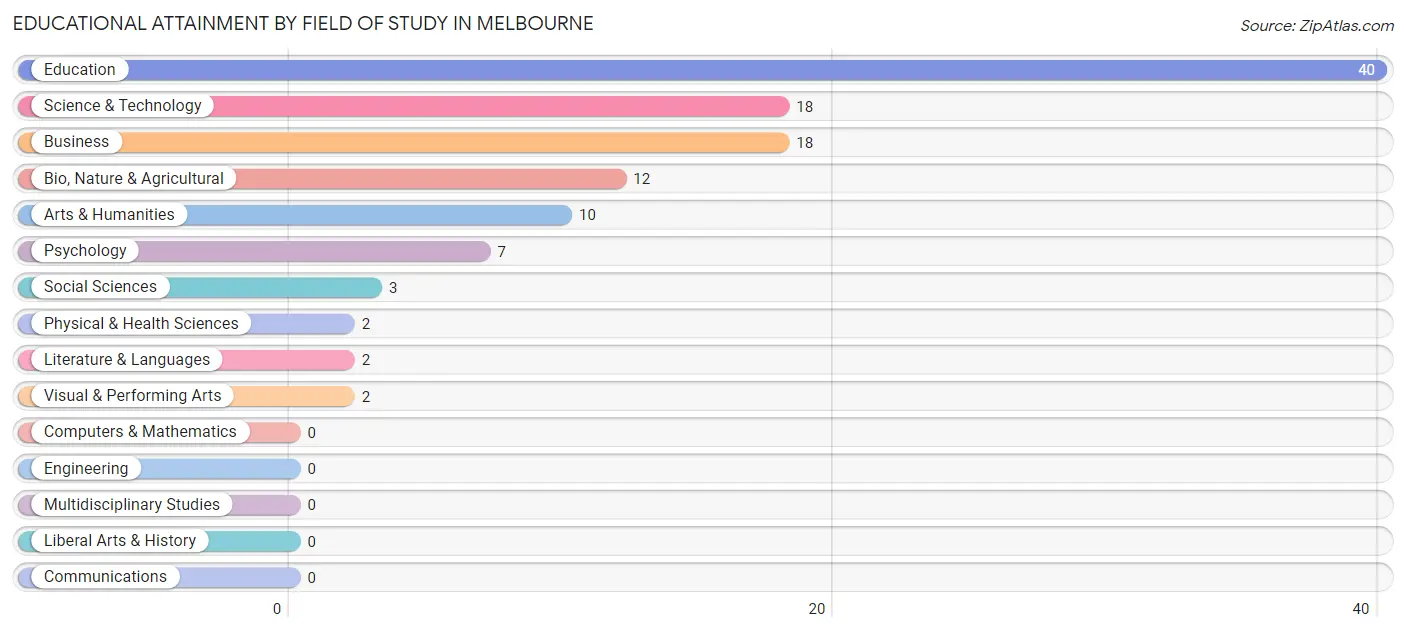
| Field of Study | # Graduates | % Graduates |
| Computers & Mathematics | 0 | 0.0% |
| Bio, Nature & Agricultural | 12 | 10.5% |
| Physical & Health Sciences | 2 | 1.8% |
| Psychology | 7 | 6.1% |
| Social Sciences | 3 | 2.6% |
| Engineering | 0 | 0.0% |
| Multidisciplinary Studies | 0 | 0.0% |
| Science & Technology | 18 | 15.8% |
| Business | 18 | 15.8% |
| Education | 40 | 35.1% |
| Literature & Languages | 2 | 1.8% |
| Liberal Arts & History | 0 | 0.0% |
| Visual & Performing Arts | 2 | 1.8% |
| Communications | 0 | 0.0% |
| Arts & Humanities | 10 | 8.8% |
| Total | 114 | 100.0% |
Transportation & Commute in Melbourne
Vehicle Availability by Sex in Melbourne
The most prevalent vehicle ownership categories in Melbourne are males with 2 vehicles (87, accounting for 39.6%) and females with 2 vehicles (51, making up 43.3%).

| Vehicles Available | Male | Female |
| No Vehicle | 2 (0.9%) | 3 (1.5%) |
| 1 Vehicle | 20 (9.1%) | 41 (20.4%) |
| 2 Vehicles | 87 (39.6%) | 51 (25.4%) |
| 3 Vehicles | 79 (35.9%) | 71 (35.3%) |
| 4 Vehicles | 12 (5.4%) | 19 (9.5%) |
| 5 or more Vehicles | 20 (9.1%) | 16 (8.0%) |
| Total | 220 (100.0%) | 201 (100.0%) |
Commute Time in Melbourne
The most frequently occuring commute durations in Melbourne are 20 to 24 minutes (95 commuters, 24.7%), 15 to 19 minutes (43 commuters, 11.2%), and 25 to 29 minutes (43 commuters, 11.2%).
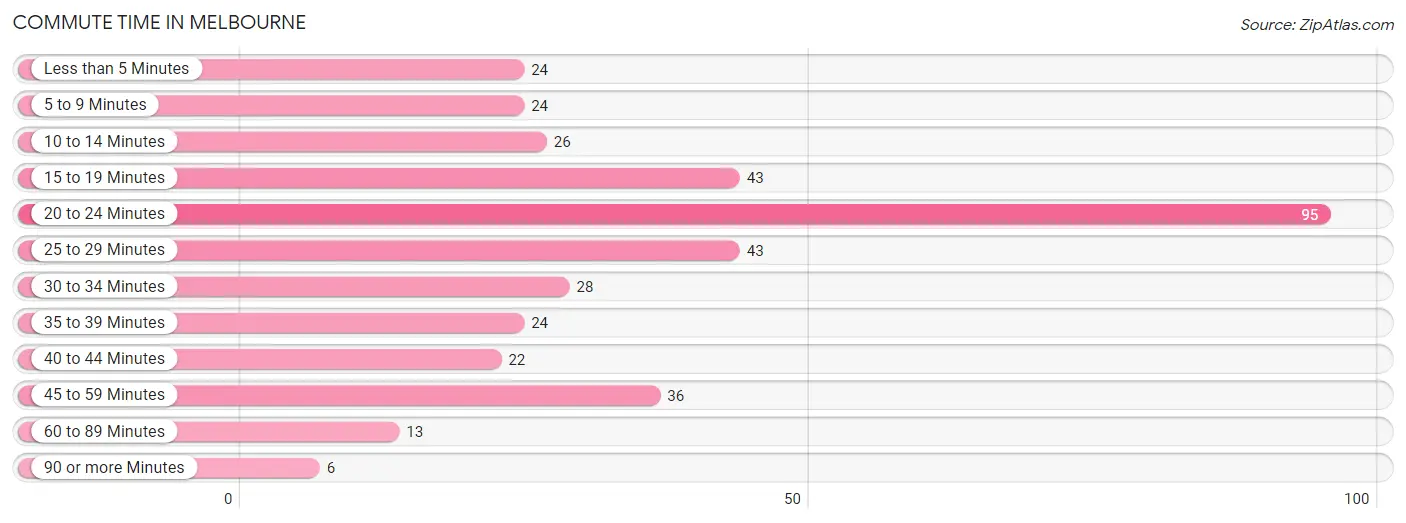
| Commute Time | # Commuters | % Commuters |
| Less than 5 Minutes | 24 | 6.2% |
| 5 to 9 Minutes | 24 | 6.2% |
| 10 to 14 Minutes | 26 | 6.8% |
| 15 to 19 Minutes | 43 | 11.2% |
| 20 to 24 Minutes | 95 | 24.7% |
| 25 to 29 Minutes | 43 | 11.2% |
| 30 to 34 Minutes | 28 | 7.3% |
| 35 to 39 Minutes | 24 | 6.2% |
| 40 to 44 Minutes | 22 | 5.7% |
| 45 to 59 Minutes | 36 | 9.4% |
| 60 to 89 Minutes | 13 | 3.4% |
| 90 or more Minutes | 6 | 1.6% |
Commute Time by Sex in Melbourne
The most common commute times in Melbourne are 20 to 24 minutes (46 commuters, 22.6%) for males and 20 to 24 minutes (49 commuters, 27.2%) for females.
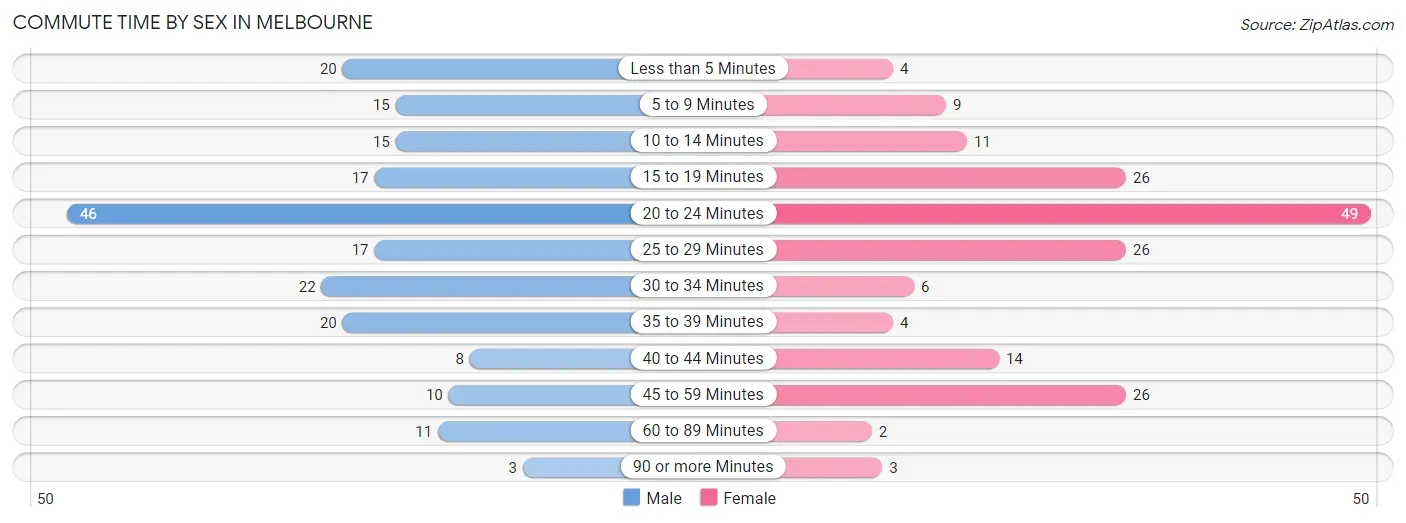
| Commute Time | Male | Female |
| Less than 5 Minutes | 20 (9.8%) | 4 (2.2%) |
| 5 to 9 Minutes | 15 (7.3%) | 9 (5.0%) |
| 10 to 14 Minutes | 15 (7.3%) | 11 (6.1%) |
| 15 to 19 Minutes | 17 (8.3%) | 26 (14.4%) |
| 20 to 24 Minutes | 46 (22.6%) | 49 (27.2%) |
| 25 to 29 Minutes | 17 (8.3%) | 26 (14.4%) |
| 30 to 34 Minutes | 22 (10.8%) | 6 (3.3%) |
| 35 to 39 Minutes | 20 (9.8%) | 4 (2.2%) |
| 40 to 44 Minutes | 8 (3.9%) | 14 (7.8%) |
| 45 to 59 Minutes | 10 (4.9%) | 26 (14.4%) |
| 60 to 89 Minutes | 11 (5.4%) | 2 (1.1%) |
| 90 or more Minutes | 3 (1.5%) | 3 (1.7%) |
Time of Departure to Work by Sex in Melbourne
The most frequent times of departure to work in Melbourne are 7:00 AM to 7:29 AM (43, 21.1%) for males and 8:00 AM to 8:29 AM (32, 17.8%) for females.
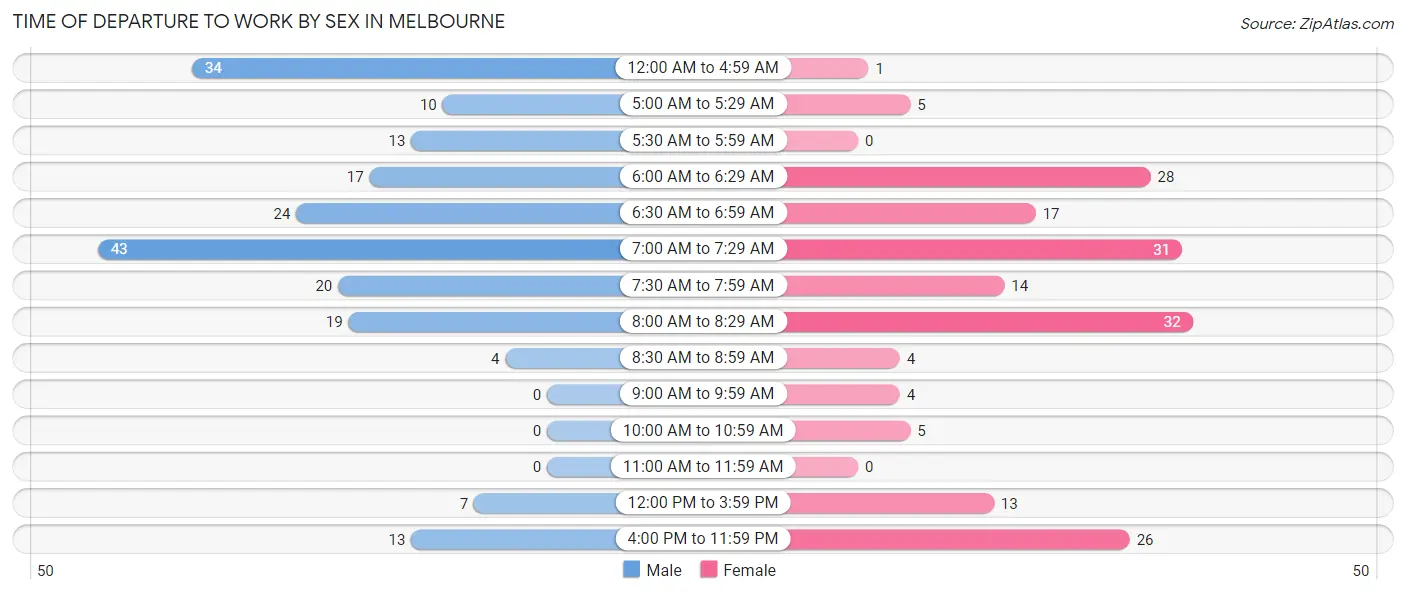
| Time of Departure | Male | Female |
| 12:00 AM to 4:59 AM | 34 (16.7%) | 1 (0.6%) |
| 5:00 AM to 5:29 AM | 10 (4.9%) | 5 (2.8%) |
| 5:30 AM to 5:59 AM | 13 (6.4%) | 0 (0.0%) |
| 6:00 AM to 6:29 AM | 17 (8.3%) | 28 (15.6%) |
| 6:30 AM to 6:59 AM | 24 (11.8%) | 17 (9.4%) |
| 7:00 AM to 7:29 AM | 43 (21.1%) | 31 (17.2%) |
| 7:30 AM to 7:59 AM | 20 (9.8%) | 14 (7.8%) |
| 8:00 AM to 8:29 AM | 19 (9.3%) | 32 (17.8%) |
| 8:30 AM to 8:59 AM | 4 (2.0%) | 4 (2.2%) |
| 9:00 AM to 9:59 AM | 0 (0.0%) | 4 (2.2%) |
| 10:00 AM to 10:59 AM | 0 (0.0%) | 5 (2.8%) |
| 11:00 AM to 11:59 AM | 0 (0.0%) | 0 (0.0%) |
| 12:00 PM to 3:59 PM | 7 (3.4%) | 13 (7.2%) |
| 4:00 PM to 11:59 PM | 13 (6.4%) | 26 (14.4%) |
| Total | 204 (100.0%) | 180 (100.0%) |
Housing Occupancy in Melbourne
Occupancy by Ownership in Melbourne
Of the total 294 dwellings in Melbourne, owner-occupied units account for 252 (85.7%), while renter-occupied units make up 42 (14.3%).

| Occupancy | # Housing Units | % Housing Units |
| Owner Occupied Housing Units | 252 | 85.7% |
| Renter-Occupied Housing Units | 42 | 14.3% |
| Total Occupied Housing Units | 294 | 100.0% |
Occupancy by Household Size in Melbourne

| Household Size | # Housing Units | % Housing Units |
| 1-Person Household | 54 | 18.4% |
| 2-Person Household | 108 | 36.7% |
| 3-Person Household | 48 | 16.3% |
| 4+ Person Household | 84 | 28.6% |
| Total Housing Units | 294 | 100.0% |
Occupancy by Ownership by Household Size in Melbourne

| Household Size | Owner-occupied | Renter-occupied |
| 1-Person Household | 42 (77.8%) | 12 (22.2%) |
| 2-Person Household | 84 (77.8%) | 24 (22.2%) |
| 3-Person Household | 43 (89.6%) | 5 (10.4%) |
| 4+ Person Household | 83 (98.8%) | 1 (1.2%) |
| Total Housing Units | 252 (85.7%) | 42 (14.3%) |
Occupancy by Educational Attainment in Melbourne

| Household Size | Owner-occupied | Renter-occupied |
| Less than High School | 4 (66.7%) | 2 (33.3%) |
| High School Diploma | 68 (70.1%) | 29 (29.9%) |
| College/Associate Degree | 113 (91.1%) | 11 (8.9%) |
| Bachelor's Degree or higher | 67 (100.0%) | 0 (0.0%) |
Occupancy by Age of Householder in Melbourne

| Age Bracket | # Households | % Households |
| Under 35 Years | 63 | 21.4% |
| 35 to 44 Years | 76 | 25.9% |
| 45 to 54 Years | 39 | 13.3% |
| 55 to 64 Years | 37 | 12.6% |
| 65 to 74 Years | 50 | 17.0% |
| 75 to 84 Years | 27 | 9.2% |
| 85 Years and Over | 2 | 0.7% |
| Total | 294 | 100.0% |
Housing Finances in Melbourne
Median Income by Occupancy in Melbourne

| Occupancy Type | # Households | Median Income |
| Owner-Occupied | 252 (85.7%) | $97,500 |
| Renter-Occupied | 42 (14.3%) | $50,938 |
| Average | 294 (100.0%) | $91,500 |
Occupancy by Householder Income Bracket in Melbourne
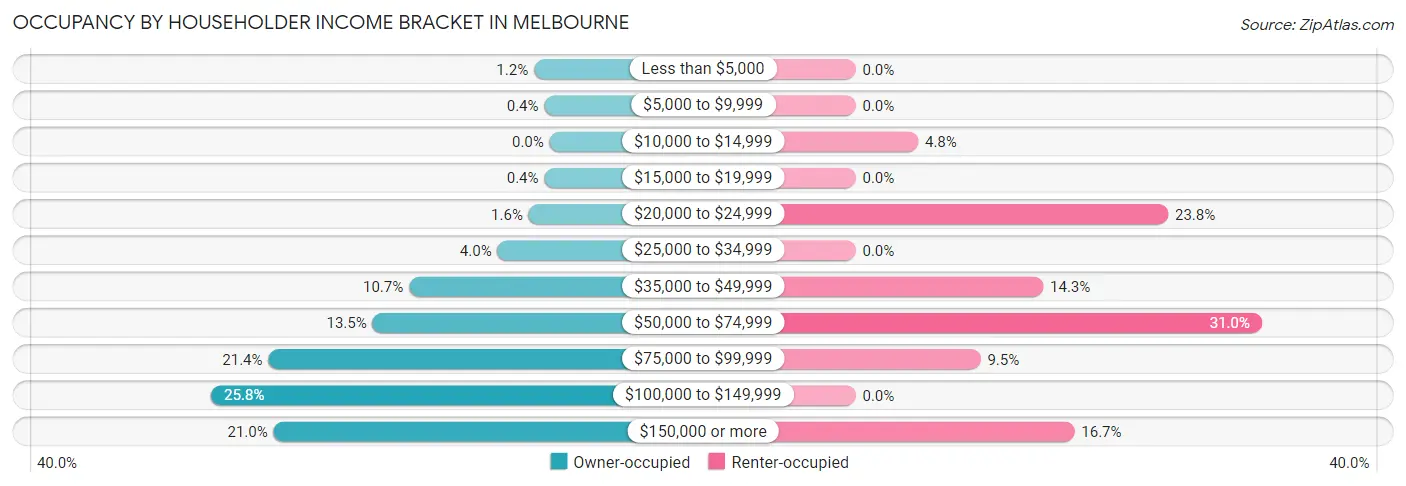
| Income Bracket | Owner-occupied | Renter-occupied |
| Less than $5,000 | 3 (1.2%) | 0 (0.0%) |
| $5,000 to $9,999 | 1 (0.4%) | 0 (0.0%) |
| $10,000 to $14,999 | 0 (0.0%) | 2 (4.8%) |
| $15,000 to $19,999 | 1 (0.4%) | 0 (0.0%) |
| $20,000 to $24,999 | 4 (1.6%) | 10 (23.8%) |
| $25,000 to $34,999 | 10 (4.0%) | 0 (0.0%) |
| $35,000 to $49,999 | 27 (10.7%) | 6 (14.3%) |
| $50,000 to $74,999 | 34 (13.5%) | 13 (30.9%) |
| $75,000 to $99,999 | 54 (21.4%) | 4 (9.5%) |
| $100,000 to $149,999 | 65 (25.8%) | 0 (0.0%) |
| $150,000 or more | 53 (21.0%) | 7 (16.7%) |
| Total | 252 (100.0%) | 42 (100.0%) |
Monthly Housing Cost Tiers in Melbourne

| Monthly Cost | Owner-occupied | Renter-occupied |
| Less than $300 | 12 (4.8%) | 0 (0.0%) |
| $300 to $499 | 29 (11.5%) | 1 (2.4%) |
| $500 to $799 | 54 (21.4%) | 25 (59.5%) |
| $800 to $999 | 28 (11.1%) | 0 (0.0%) |
| $1,000 to $1,499 | 92 (36.5%) | 12 (28.6%) |
| $1,500 to $1,999 | 34 (13.5%) | 0 (0.0%) |
| $2,000 to $2,499 | 3 (1.2%) | 0 (0.0%) |
| $2,500 to $2,999 | 0 (0.0%) | 0 (0.0%) |
| $3,000 or more | 0 (0.0%) | 0 (0.0%) |
| Total | 252 (100.0%) | 42 (100.0%) |
Physical Housing Characteristics in Melbourne
Housing Structures in Melbourne

| Structure Type | # Housing Units | % Housing Units |
| Single Unit, Detached | 261 | 88.8% |
| Single Unit, Attached | 0 | 0.0% |
| 2 Unit Apartments | 0 | 0.0% |
| 3 or 4 Unit Apartments | 21 | 7.1% |
| 5 to 9 Unit Apartments | 0 | 0.0% |
| 10 or more Apartments | 0 | 0.0% |
| Mobile Home / Other | 12 | 4.1% |
| Total | 294 | 100.0% |
Housing Structures by Occupancy in Melbourne

| Structure Type | Owner-occupied | Renter-occupied |
| Single Unit, Detached | 244 (93.5%) | 17 (6.5%) |
| Single Unit, Attached | 0 (0.0%) | 0 (0.0%) |
| 2 Unit Apartments | 0 (0.0%) | 0 (0.0%) |
| 3 or 4 Unit Apartments | 0 (0.0%) | 21 (100.0%) |
| 5 to 9 Unit Apartments | 0 (0.0%) | 0 (0.0%) |
| 10 or more Apartments | 0 (0.0%) | 0 (0.0%) |
| Mobile Home / Other | 8 (66.7%) | 4 (33.3%) |
| Total | 252 (85.7%) | 42 (14.3%) |
Housing Structures by Number of Rooms in Melbourne

| Number of Rooms | Owner-occupied | Renter-occupied |
| 1 Room | 0 (0.0%) | 0 (0.0%) |
| 2 or 3 Rooms | 3 (1.2%) | 18 (42.9%) |
| 4 or 5 Rooms | 49 (19.4%) | 22 (52.4%) |
| 6 or 7 Rooms | 132 (52.4%) | 2 (4.8%) |
| 8 or more Rooms | 68 (27.0%) | 0 (0.0%) |
| Total | 252 (100.0%) | 42 (100.0%) |
Housing Structure by Heating Type in Melbourne

| Heating Type | Owner-occupied | Renter-occupied |
| Utility Gas | 181 (71.8%) | 30 (71.4%) |
| Bottled, Tank, or LP Gas | 7 (2.8%) | 0 (0.0%) |
| Electricity | 58 (23.0%) | 12 (28.6%) |
| Fuel Oil or Kerosene | 2 (0.8%) | 0 (0.0%) |
| Coal or Coke | 0 (0.0%) | 0 (0.0%) |
| All other Fuels | 4 (1.6%) | 0 (0.0%) |
| No Fuel Used | 0 (0.0%) | 0 (0.0%) |
| Total | 252 (100.0%) | 42 (100.0%) |
Household Vehicle Usage in Melbourne

| Vehicles per Household | Owner-occupied | Renter-occupied |
| No Vehicle | 6 (2.4%) | 1 (2.4%) |
| 1 Vehicle | 43 (17.1%) | 23 (54.8%) |
| 2 Vehicles | 92 (36.5%) | 16 (38.1%) |
| 3 or more Vehicles | 111 (44.1%) | 2 (4.8%) |
| Total | 252 (100.0%) | 42 (100.0%) |
Real Estate & Mortgages in Melbourne
Real Estate and Mortgage Overview in Melbourne
| Characteristic | Without Mortgage | With Mortgage |
| Housing Units | 87 | 165 |
| Median Property Value | $128,800 | $143,400 |
| Median Household Income | $69,375 | $37 |
| Monthly Housing Costs | $523 | $0 |
| Real Estate Taxes | $1,750 | $8 |
Property Value by Mortgage Status in Melbourne

| Property Value | Without Mortgage | With Mortgage |
| Less than $50,000 | 2 (2.3%) | 5 (3.0%) |
| $50,000 to $99,999 | 33 (37.9%) | 45 (27.3%) |
| $100,000 to $299,999 | 52 (59.8%) | 103 (62.4%) |
| $300,000 to $499,999 | 0 (0.0%) | 4 (2.4%) |
| $500,000 to $749,999 | 0 (0.0%) | 8 (4.9%) |
| $750,000 to $999,999 | 0 (0.0%) | 0 (0.0%) |
| $1,000,000 or more | 0 (0.0%) | 0 (0.0%) |
| Total | 87 (100.0%) | 165 (100.0%) |
Household Income by Mortgage Status in Melbourne

| Household Income | Without Mortgage | With Mortgage |
| Less than $10,000 | 4 (4.6%) | 4 (2.4%) |
| $10,000 to $24,999 | 4 (4.6%) | 0 (0.0%) |
| $25,000 to $34,999 | 4 (4.6%) | 1 (0.6%) |
| $35,000 to $49,999 | 11 (12.6%) | 6 (3.6%) |
| $50,000 to $74,999 | 21 (24.1%) | 16 (9.7%) |
| $75,000 to $99,999 | 9 (10.3%) | 13 (7.9%) |
| $100,000 to $149,999 | 18 (20.7%) | 45 (27.3%) |
| $150,000 or more | 16 (18.4%) | 47 (28.5%) |
| Total | 87 (100.0%) | 165 (100.0%) |
Property Value to Household Income Ratio in Melbourne

| Value-to-Income Ratio | Without Mortgage | With Mortgage |
| Less than 2.0x | 48 (55.2%) | 101,875 (61,742.4%) |
| 2.0x to 2.9x | 18 (20.7%) | 127 (77.0%) |
| 3.0x to 3.9x | 9 (10.3%) | 21 (12.7%) |
| 4.0x or more | 12 (13.8%) | 7 (4.2%) |
| Total | 87 (100.0%) | 165 (100.0%) |
Real Estate Taxes by Mortgage Status in Melbourne

| Property Taxes | Without Mortgage | With Mortgage |
| Less than $800 | 2 (2.3%) | 0 (0.0%) |
| $800 to $1,499 | 32 (36.8%) | 21 (12.7%) |
| $800 to $1,499 | 51 (58.6%) | 42 (25.5%) |
| Total | 87 (100.0%) | 165 (100.0%) |
Health & Disability in Melbourne
Health Insurance Coverage by Age in Melbourne

| Age Bracket | With Coverage | Without Coverage |
| Under 6 Years | 81 (95.3%) | 4 (4.7%) |
| 6 to 18 Years | 183 (100.0%) | 0 (0.0%) |
| 19 to 25 Years | 45 (95.7%) | 2 (4.3%) |
| 26 to 34 Years | 62 (84.9%) | 11 (15.1%) |
| 35 to 44 Years | 147 (97.4%) | 4 (2.6%) |
| 45 to 54 Years | 66 (86.8%) | 10 (13.2%) |
| 55 to 64 Years | 52 (92.9%) | 4 (7.1%) |
| 65 to 74 Years | 73 (100.0%) | 0 (0.0%) |
| 75 Years and older | 44 (100.0%) | 0 (0.0%) |
| Total | 753 (95.6%) | 35 (4.4%) |
Health Insurance Coverage by Citizenship Status in Melbourne

| Citizenship Status | With Coverage | Without Coverage |
| Native Born | 81 (95.3%) | 4 (4.7%) |
| Foreign Born, Citizen | 183 (100.0%) | 0 (0.0%) |
| Foreign Born, not a Citizen | 45 (95.7%) | 2 (4.3%) |
Health Insurance Coverage by Household Income in Melbourne

| Household Income | With Coverage | Without Coverage |
| Under $25,000 | 28 (93.3%) | 2 (6.7%) |
| $25,000 to $49,999 | 53 (81.5%) | 12 (18.5%) |
| $50,000 to $74,999 | 77 (89.5%) | 9 (10.5%) |
| $75,000 to $99,999 | 193 (100.0%) | 0 (0.0%) |
| $100,000 and over | 402 (97.1%) | 12 (2.9%) |
Public vs Private Health Insurance Coverage by Age in Melbourne

| Age Bracket | Public Insurance | Private Insurance |
| Under 6 | 17 (20.0%) | 64 (75.3%) |
| 6 to 18 Years | 55 (30.0%) | 145 (79.2%) |
| 19 to 25 Years | 7 (14.9%) | 38 (80.8%) |
| 25 to 34 Years | 0 (0.0%) | 62 (84.9%) |
| 35 to 44 Years | 18 (11.9%) | 131 (86.8%) |
| 45 to 54 Years | 6 (7.9%) | 60 (78.9%) |
| 55 to 64 Years | 11 (19.6%) | 43 (76.8%) |
| 65 to 74 Years | 67 (91.8%) | 61 (83.6%) |
| 75 Years and over | 44 (100.0%) | 23 (52.3%) |
| Total | 225 (28.5%) | 627 (79.6%) |
Disability Status by Sex by Age in Melbourne

| Age Bracket | Male | Female |
| Under 5 Years | 0 (0.0%) | 0 (0.0%) |
| 5 to 17 Years | 6 (5.4%) | 4 (5.3%) |
| 18 to 34 Years | 2 (3.1%) | 12 (19.7%) |
| 35 to 64 Years | 19 (12.3%) | 18 (14.0%) |
| 65 to 74 Years | 6 (19.4%) | 7 (16.7%) |
| 75 Years and over | 10 (66.7%) | 11 (37.9%) |
Disability Class by Sex by Age in Melbourne
Disability Class: Hearing Difficulty

| Age Bracket | Male | Female |
| Under 5 Years | 0 (0.0%) | 0 (0.0%) |
| 5 to 17 Years | 0 (0.0%) | 0 (0.0%) |
| 18 to 34 Years | 0 (0.0%) | 0 (0.0%) |
| 35 to 64 Years | 0 (0.0%) | 5 (3.9%) |
| 65 to 74 Years | 4 (12.9%) | 4 (9.5%) |
| 75 Years and over | 9 (60.0%) | 10 (34.5%) |
Disability Class: Vision Difficulty

| Age Bracket | Male | Female |
| Under 5 Years | 0 (0.0%) | 0 (0.0%) |
| 5 to 17 Years | 0 (0.0%) | 0 (0.0%) |
| 18 to 34 Years | 2 (3.1%) | 0 (0.0%) |
| 35 to 64 Years | 0 (0.0%) | 0 (0.0%) |
| 65 to 74 Years | 0 (0.0%) | 0 (0.0%) |
| 75 Years and over | 0 (0.0%) | 1 (3.5%) |
Disability Class: Cognitive Difficulty

| Age Bracket | Male | Female |
| 5 to 17 Years | 6 (5.4%) | 4 (5.3%) |
| 18 to 34 Years | 0 (0.0%) | 12 (19.7%) |
| 35 to 64 Years | 15 (9.7%) | 11 (8.5%) |
| 65 to 74 Years | 0 (0.0%) | 0 (0.0%) |
| 75 Years and over | 0 (0.0%) | 1 (3.5%) |
Disability Class: Ambulatory Difficulty

| Age Bracket | Male | Female |
| 5 to 17 Years | 2 (1.8%) | 0 (0.0%) |
| 18 to 34 Years | 0 (0.0%) | 0 (0.0%) |
| 35 to 64 Years | 6 (3.9%) | 7 (5.4%) |
| 65 to 74 Years | 4 (12.9%) | 7 (16.7%) |
| 75 Years and over | 2 (13.3%) | 1 (3.5%) |
Disability Class: Self-Care Difficulty

| Age Bracket | Male | Female |
| 5 to 17 Years | 0 (0.0%) | 0 (0.0%) |
| 18 to 34 Years | 0 (0.0%) | 0 (0.0%) |
| 35 to 64 Years | 2 (1.3%) | 2 (1.5%) |
| 65 to 74 Years | 0 (0.0%) | 0 (0.0%) |
| 75 Years and over | 0 (0.0%) | 1 (3.5%) |
Technology Access in Melbourne
Computing Device Access in Melbourne

| Device Type | # Households | % Households |
| Desktop or Laptop | 224 | 76.2% |
| Smartphone | 274 | 93.2% |
| Tablet | 175 | 59.5% |
| No Computing Device | 13 | 4.4% |
| Total | 294 | 100.0% |
Internet Access in Melbourne

| Internet Type | # Households | % Households |
| Dial-Up Internet | 1 | 0.3% |
| Broadband Home | 177 | 60.2% |
| Cellular Data Only | 38 | 12.9% |
| Satellite Internet | 33 | 11.2% |
| No Internet | 45 | 15.3% |
| Total | 294 | 100.0% |
Melbourne Summary
Melbourne, Iowa is a small city located in Marshall County, Iowa. It is situated on the banks of the Iowa River and is part of the Marshalltown, Iowa Metropolitan Statistical Area. The city has a population of approximately 1,500 people and is the county seat of Marshall County.
Geography
Melbourne is located in the central part of Iowa, approximately 50 miles northeast of Des Moines. It is situated on the banks of the Iowa River and is surrounded by rolling hills and farmland. The city is located at an elevation of 890 feet above sea level. The climate in Melbourne is characterized by hot, humid summers and cold, snowy winters.
Economy
The economy of Melbourne is largely based on agriculture and manufacturing. The city is home to several large agricultural operations, including a large hog farm and a large dairy farm. The city also has several manufacturing plants, including a plastics plant and a metal fabrication plant. The city also has a number of small businesses, including restaurants, retail stores, and service providers.
Demographics
As of the 2010 census, the population of Melbourne was 1,500. The racial makeup of the city was 97.2% White, 0.7% African American, 0.2% Native American, 0.2% Asian, 0.2% from other races, and 1.7% from two or more races. Hispanic or Latino of any race were 1.3% of the population.
The median income for a household in the city was $41,250, and the median income for a family was $50,000. The per capita income for the city was $20,845. About 8.2% of families and 10.2% of the population were below the poverty line, including 14.3% of those under age 18 and 8.3% of those age 65 or over.
History
Melbourne was founded in 1856 by a group of settlers from Ohio. The city was named after Melbourne, Australia, and was incorporated in 1875. The city was an important stop on the Chicago, Rock Island and Pacific Railroad, and the city grew rapidly in the late 19th and early 20th centuries.
In the early 20th century, Melbourne was a major center for the production of agricultural equipment. The city was also home to several large manufacturing plants, including a plastics plant and a metal fabrication plant.
In the late 20th century, Melbourne experienced a period of economic decline. The city's population declined from a peak of 2,000 in the 1950s to 1,500 in the 2010 census. Despite this decline, the city has remained an important center for agriculture and manufacturing in the region.
Common Questions
What is Per Capita Income in Melbourne?
Per Capita income in Melbourne is $35,613.
What is the Median Family Income in Melbourne?
Median Family Income in Melbourne is $103,125.
What is the Median Household income in Melbourne?
Median Household Income in Melbourne is $91,500.
What is Income or Wage Gap in Melbourne?
Income or Wage Gap in Melbourne is 32.7%.
Women in Melbourne earn 67.3 cents for every dollar earned by a man.
What is Inequality or Gini Index in Melbourne?
Inequality or Gini Index in Melbourne is 0.33.
What is the Total Population of Melbourne?
Total Population of Melbourne is 788.
What is the Total Male Population of Melbourne?
Total Male Population of Melbourne is 432.
What is the Total Female Population of Melbourne?
Total Female Population of Melbourne is 356.
What is the Ratio of Males per 100 Females in Melbourne?
There are 121.35 Males per 100 Females in Melbourne.
What is the Ratio of Females per 100 Males in Melbourne?
There are 82.41 Females per 100 Males in Melbourne.
What is the Median Population Age in Melbourne?
Median Population Age in Melbourne is 35.5 Years.
What is the Average Family Size in Melbourne
Average Family Size in Melbourne is 3.1 People.
What is the Average Household Size in Melbourne
Average Household Size in Melbourne is 2.7 People.
How Large is the Labor Force in Melbourne?
There are 445 People in the Labor Forcein in Melbourne.
What is the Percentage of People in the Labor Force in Melbourne?
80.8% of People are in the Labor Force in Melbourne.
What is the Unemployment Rate in Melbourne?
Unemployment Rate in Melbourne is 4.3%.